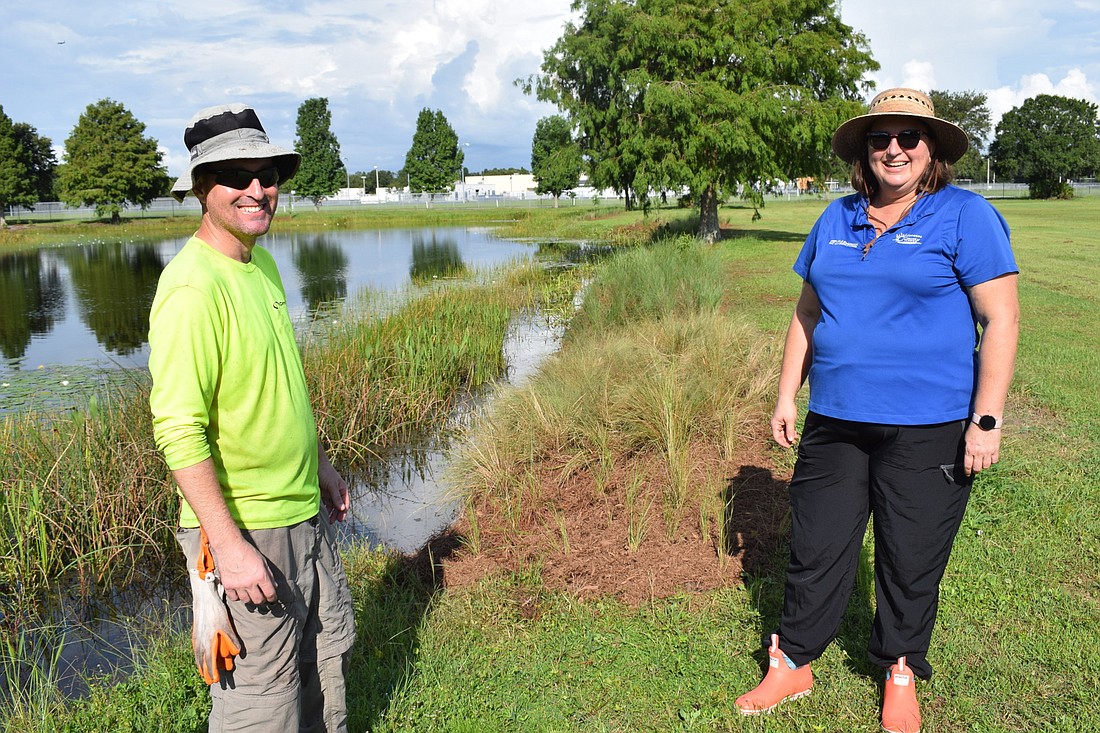- April 11, 2025
-
-
Loading

Loading

The fact you love the unobstructed view of that little lake outside your East County home could be causing major pollution in local waterways.
Michelle Atkinson, an extension agent in Manatee County for the University of Florida's Institute of Food and Agricultural Sciences, said some builders and homeowners might have lost sight of the role their stormwater ponds are supposed to play.
And, yes, Atkinson notes, those bodies of water — more than 1,000 in the Lakewood Ranch area alone — are not lakes. They were dug to help filter stormwater that ends up in rivers and, eventually, the gulf.
Atkinson joked they are more ditches than lakes, but that's OK, if they serve their intended purpose.
Help could be on the way.
University of Florida researchers with the UF Institute of Food and Agricultural Sciences, are studying how efficient plants can be absorbing nitrogen and phosphorus found in stormwater that is running unabated into the ponds.
Many stormwater ponds constructed by builders have turf running right to water's edge. It makes it easier to mow and maintain the area and it creates a great view for homeowners.
Using a $197,000 Environmental Protection Agency grant, the UF/IFAS is conducting a four-year study using plants around the edge of stormwater ponds to see if the stormwater is significantly filtered entering the ponds. Atkinson is overseeing the effort in Manatee County, where four ponds have been selected for the study.
One of the ponds is at Greenbrook County Park in Lakewood Ranch and another is on Cooper Creek Boulevard in East County. The other two are at the Bradenton Area Convention Center in Palmetto.
While studies have been conducted with Midwest farms using plants to border their fields before fertilizer reaches the waterways, little research has been done on stormwater ponds.
A similar study was done two years ago using Lakewood Ranch stormwater ponds, but Atkinson explain only partial borders of the ponds were lined with plants. Even so, researchers found 20% less phosphorus in the ponds.
The current study uses plants around the entire border, with only a few minor breaks for access. None of the plants reaches more than 3 feet high so as not to block the homeowners' views.
“What we learn can be applied to existing and new stormwater ponds in Florida’s rapidly expanding residential landscapes,” said Basil Iannone, a UF/IFAS assistant professor of urban landscape ecology. “This is important because we need to find ways to limit the nutrients getting into Florida’s valuable water resources."
UF/IFAS said more than 76,000 stormwater ponds exist in Florida.
If the numbers — planted vs. unplanted ponds will be studied — indicate a substantial reduction in nutrients, researchers hope to develop an education plan to convince builders, homeowners and homeowners associations to adopt similar planting around their ponds, and in building future stormwater ponds.
“We want to see if the plants improve stormwater pond quality,” Iannone said. “We also want to gauge people’s willingness to adopt the idea of plantings, and we want to identify the best ways to educate people about the benefits of installing plants in and around stormwater ponds.”
That won't be an easy sell according to Chris White, a senior consultant for Riverview's Cardno, a habitat restoration business. White's crew was doing the planting just outside the pond's edge in Greenbrook County Park and also is doing the work at the other Manatee County ponds used in the study.
"Developers aren't that interested," he said. "They are selling lakes."
However, White said builders and homeowners will find that the plants improve the quality of the water and bring in more wildlife. He said the plants along the inside of the ponds creates hiding spots for fish and makes them less vulnerable to birds.
He said spreading the word about the benefits is imperative and notes that should include tours given to HOA managers and visits to HOA boards and town halls. He said the work, such as that done at the pond in Greenbrook, can be completed for less than $10,000.
For information on the actually planting, White can be reached at Chris.White@Cardno.com.
The stormwater headed toward the ponds often includes fertilizer, grass clippings, yard debris and pet waste.
Atkinson said the plants act as a first line of defense and a stormwater buffer zone.
"This is going to slow the flow of water going into the ponds," she said of the added plants. "It's good for the wildlife and it doesn't invite alligators. Birds can come and pick out insects."
Among the grasses planted around the Greenbrook pond are thalia and bulrush.
She said it can be a tough sell without research data.
"If there were no plants when a house was purchased (on a stormwater pond), the owners don't want the plants. They were sold a lake. The reject the idea of plants because it blocks their view of the water. People don't understand the concept.
"This really starts with the developer and it costs money."
Atkinson said those conducting the study are hoping to see a 40% reduction in nutrients with the added plants. She said it is essential to convince people the plants are needed.
"We are overloading the rivers (with nutrients)," she said.
She said once significant study numbers are counted in about a year, signs will be added at the study sites to explain the concept. She said Manatee County currently has an ordinance that recommends the plants, but nothing is required.
For more information on the study, contact Paul Monaghan, a UF/IFAS associate professor of agricultural education and communication, at Paulf@ufl.edu.